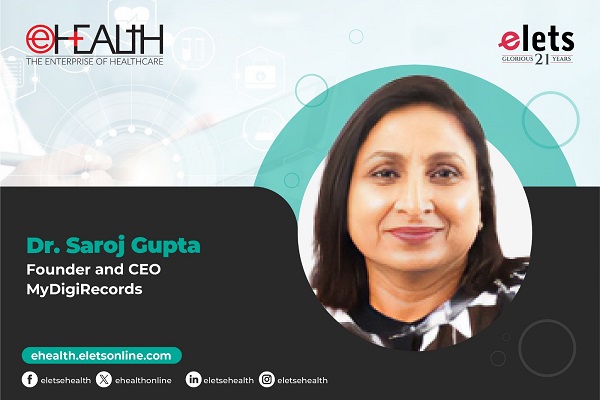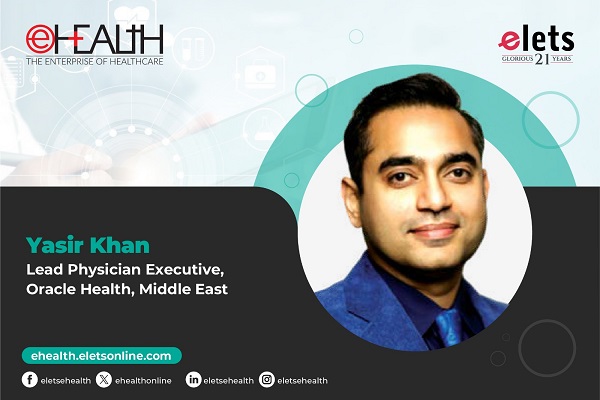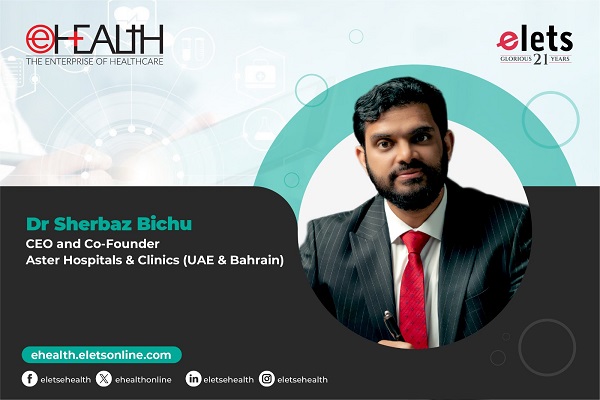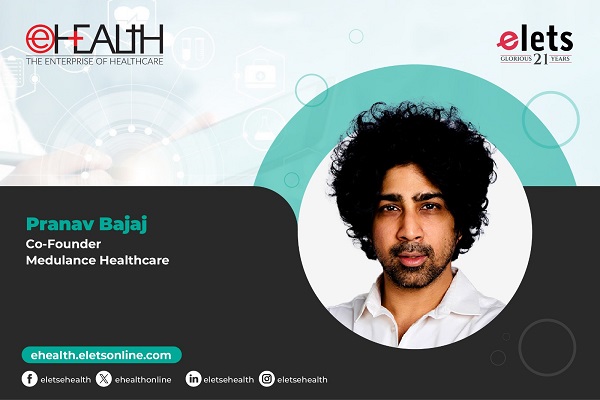

Divyalok Sharma, Senior Director – Client Development, Pearson VUE
The need of the hour is to expose the policymakers to new high-end assessment tools and their benefits to address the growing challenges in the medical education and examinations across the Indian healthcare landscape, shares Divyalok Sharma, Senior Director – Client Development, Pearson VUE exclusively with Kusum Kumari of Elets News Network (ENN)
Pearson VUE is the global leader in computer-based testing for high-stakes certification and licensure exams in the healthcare, finance, etc. Please share the details regarding geographical footprint, clients, etc.

Pearson VUE is a part of mothership called Pearson, which is a global United Kingdom (UK) based organisation. Pearson VUE is part of their assessment vertical. At this point in time, we are the worlds largest assessment & certification organisation in terms of everything, ranging from size, revenue generation, clients, geographical footprint, etc. Overall, Pearson VUE is present in 180 countries and has more than 5,500 testing centres across the globe. We deliver more than 14 million examinations across the globe, which means we are delivering some exams at some point of time in some country. In the Indian context, we have more than 350 testing centres (brick & mortar testing centres) across 92 cities. We have more than 450 active clients globally. As such, the key value we bring to the table is a convenience to students and increased reach. As the entire methodology of developing medical examinations is a very time-consuming & costly affair, Pearson VUE plays a key role in creating a very secure environment to ensure only right candidates undertake tests. We are glad that global organisations have started giving value to candidates convenience, which is being considered even in India, though its a long road ahead. The idea is to identify skills and not do filtration.
Lately, there has been anincreased debate on thelack of hands-on experience amongst medical personnel. In the light of the above, how do you judge hands on experience of medical students through your assessments?

Pearson Vues state-of-the-art testing centres are enabled with high-end technologies to detect fraud activities
Our primary goal through testing is to check the knowledge level of students and not conduct filtration. The entire assessment has complete science behind it and thats the reason computer-based testing is different from others, where we need to have a pretested large pool of questions for random selection. Though various modes of testing are available, our tests enable to test a persons knowledge and understand his/her depth on particular topics or concepts.

Psychometrics and science are included in the entire structure of the assessment. As the system automatically gives a similar level of options to candidates based on their answers, we are able to define the level of each student. In order to know the hands-on skills of medical students, we integrate real-life like scenarios virtually to determine their knowledge. Pearson VUE has created a similar kind of lab with the Australian Medical Council to test students practical knowledge. Technology can definitely assist global companies in finding the right candidates. The companies like Pearson VUE and others have that kind of high-end technology and know-how available with them that can assist companies to find the right candidates. Its all about exposure about such technologies among the policymakers, as such technologies, come with a cost.
Do you have in-house experts and research & development (R&D) or you outsource to others?
In order to design such high-end and world-class assessment tools or tests, we need appropriate domain knowhow and collaborations with experts to integrate their inputs in the tests. As such, we work very closely with many medical organisations (more than 450 clients), who are aware of the loopholes/gaps in the current assessment patterns and can enhance the tests through their feedback. These companies come to our experts and platforms to structure assessment based on the best practices, domain knowhow and technology. For example, we work very closely with the well-renowned Australian Medical Council, Royal College of London, etc. We cover all healthcare stakeholders by also working with the Australian Pharmacy Council, Australian Dental Council, National Council Licensure Examination (NCLEX) (mandatory nursing examination in the United States (US) undertaken by the people in the emerging markets), etc.
| Pearson VUE – Key Takeaways | |
|---|---|
| Present in 180 countries
Has more than 5,500 testing centres globally Delivers more than 14 million examinations globally Has over 350 testing centres (brick & mortar testing centres) across 92 cities within India Has more than 450 active clients |
|
Currently, we have comparatively less active engagement with healthcare organizations in India. However, we are definitely looking forward to strengthening our relationships to bring in our technology expertise and help these corporate, hospitals and medical organisations to test doctors. We are definitely inching towards it in a positive way.
How has the feedback been about the Pearson VUE assessment tools & certifications, especially by the policymakers? As the entire Indian healthcare is going through progressive changes, are the policymakers exposed to such international tools?
As per my reading of the overall situation, these stakeholders are far more open now than before and are definitely looking forward to corporate sector or organisations with expertise in terms of technology, content, etc., so that they can adopt these global practices. Therefore, the willingness to adopt global practices, acceptability and openness has definitely seen positive trends. The policymakers definitely want to use such technologies. With the all initial positive trends, we see people who want to adopt global practices and want to provide such services. We are very much ready to help such people. However, such a change will take some time. The key stakeholders are ready to adopt, but the change will take some time and will certainly not happen radically or rapidly. Since the healthcare system in India is very large, change will happen as a natural phenomenon. With the right leadership, medical leaders, etc. to accelerate change, we see India as one of our key markets.
How are you making all test centres more secure and quite similar from the direction of state-of-the-art infrastructure across India as there are many challenges?
We have to have consistent guidelines with regard to testing centres to be created. We are delivering examinations for the whos who of the corporate industry. It is our responsibility to secure those examination centres, which is a minimum guideline and policy. All those people who are available at the centres as proctors are Pearson-certified proctors across the globe. Post-examination, we have a team that conducts a lot of data forensic analysis to capture any kind of anomalies. In any of the testing centre, technology assists in detecting fraud methods and in maintaining high control by freezing other windows. All these proctors follow the guidelines defined by our clients. We do not allow any electronic gadget or paper/pen, unless advised, to the examination centre. Besides the infrastructure guideline, we have different biometric capturing devices according to the needs of different testing centres. We ensure in all our examinations that we capture the photograph and digital signatures of candidates for clients.In some of our centres, we also have palm vein devices and face detection technology, which are a high-end technology.
| Indian Market – Key Observations | |
|---|---|
|
The willingness to adopt global practices, acceptability & openness has definitely seen positive trends The change will take some time & will certainly not happen radically or rapidly With the right leadership, medical leaders, etc. to accelerate change, India is one of the key markets |
|

Candidate ID and digital signature
With a growing focus in the medical segment to understand the sensitivity index or emotional quotient of candidates, how is Pearson VUE integrating content that can enable understanding of such sensitivity?
All of these assessments are standard psychometric tests, which have been developed with a huge amount of research. As such, the acceptability of such tests is very high, even in the Indian market. Such tests enable to check behavioral aspects of the candidates. As sensitivity is required in the medical field, we suggest the clients and design the assessment tools accordingly. Depending on the client’s decision, we may or may not be able to integrate all the aspects.
Our psychometricians are different from psychologists who are much more into item calibration or item equating and conducting research on that. We bring some of the best research scholars of this industry of psychometric science who are based out of the United States (US) and the UK.
Please provide details of Pearson VUEs objectives in the Indian market.
Our primary objective is to first evangelize about such innovative assessment tools as developed by us, so that people understand the technology available on date and global players accessing it. We aim to bring the best practices in the market. Business is our secondary goal. Most of our initiatives are in the direction of the primary goal. In order to operate successfully, we believe in becoming ambassadors in bringing best practices in the Indian market.
Please provide details of the science involved behind any of Pearson VUEs computerbased tests.
From the perspective of examination, the entire exam starts from identifying the right blueprint (based on the population study and topics on which candidates will be tested). The blueprint involves several steps, such as identification of easy and difficult options, result processing (percentile score or raw score), item equation, etc. As the entire examination development procedure is science in itself, all psychometricians and content developers collaborate at the time of research at the time of designing the assessment, blueprint, etc. The computer-based testing brings different types of items for testing knowledge of candidates, such as MMCQ, multiple choice questions (MCQ), True or False, audio items, drag and drop, etc., and is also much quicker.
Be a part of Elets Collaborative Initiatives. Join Us for Upcoming Events and explore business opportunities. Like us on Facebook , connect with us on LinkedIn and follow us on Twitter , Instagram.












